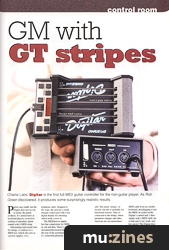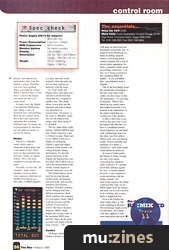Magazine Archive
Home -> Magazines -> Issues -> Articles in this issue -> View
Article Group: | |
GM with GT stripes | |
DigitarArticle from The Mix, March 1995 | |
Full MIDI guitar strumming emulator
Charlie Labs' Digitar is the first full MIDI guitar controller for the non-guitar player. As Rob Green discovered, it produces some surprisingly realistic results.

Purists may baulk, but the Digitar does not set out to mimic the guitar aesthetic. It's aimed more at keyboard players, or novices seeking to reproduce guitar sounds with a MIDI setup.
Substituting rigid metal rods for strings, it connects to a MIDI box (which also acts as a power supply), via a telephone cable. Strapped to the waist, the unit has a small, integral control pad with a tiny digital display for checking which mode you're in.
The MIDI/power supply box has connections for MIDI in, out and thru. There's an increment/decrement button at the rear of the instrument, but it's somewhat plasticky and stiff. The metal 'strings' sit loosely, but this is probably for functional reasons. They're connected to the bridge, where parameter changes and other functions are accommodated.
Getting started
When first setting up, you'll be surprised how quick it is to get into. I started by taking a MIDI cable from my mother keyboard, and plugging it into the MIDI In socket on the Digitar's control unit. I then simply took a MIDI cable out of that unit to my synth, and hey presto! The Digitar does the rest.
Basically, the Digitar takes a MIDI signal from your keyboard when a chord is played, and imprints the performance data from the Digitar's strings. Therefore you won't hear anything unless you strum the strings. When a chord of three or four notes is played, the Digitar sorts them out into a six-string chord.
In many ways, the Digitar is an elaborate MIDI merge unit, taking a series of keyboard notes and jumbling them up into a guitar chord. But it does add expression, and guitar-like reactions. Different types of chords can be programmed in, and there are four different modes of use for the Digitar.
Modes
The first is 'Rhythm' mode, which reads a minimum of three notes and a maximum of four. These notes are then translated into harmonic chords, in a guitar fashion. This is the most straightforward and effective mode.
Secondly, we have the 'All Channels' mode, which attempts to process those song sequences which are not modified for Digitar use. This takes 12 MIDI channels at a time, and only works properly when the notes are not too short (and are in harmony with the song).
In 'Lead' mode, the Digitar takes each input note, and puts it on the first free string that isn't assigned to another note. This mode allows you to play just the harmony you want without any alterations or transposition. 'Economy' is the same as 'Rhythm' mode, but uses the highest four strings only, these being D, G, B and E.
The key panel offers eight buttons, labelled MIDI In and Out, Sound, Function 1 and 2, Global (escape), Enter and Level. MIDI in and out is simply for setting the Digitar's input and output channels, while Sound is for setting program change information. To alter the general functions of the Digitar, the function keys are provided. These allow you to select the transposition of the chords, sustain (legato or staccato) and notes on or off.
The Global button can be used for moving through rhythm mode, all channels and lead mode, and can alter transpose and dynamic response. Dynamic response can be changed with four different parameters: Real, which simulates the response of a real guitar, Strum, which reads the pressure and the velocity of your hand to achieve the fastest dynamic response, MIDI, which outputs the average value of the incoming MIDI notes, and Off, where all the notes you pick will sound with the same velocity — 120.
Verdict
All things considered, Charlie Lab have come up with quite an interesting and potentially useful little tool. It might be most beneficial in a home recording situation where a convincing guitar sound is desired, but a lack of decent guitar equipment (let alone a guitarist), holds up the proceedings somewhat. I can also see it being essential for the expanding MIDI file market — if you sell MIDI files, you definitely need a Digitar.
One of the best things about this unorthodox instrument is the fact, used with a GM synth, you don't have to alter any parameters — it's just plug in and play. When I first linked up my sound source and mother keyboard. I was amazed at the authenticity of the guitar sound that was coming out of the speakers.

It takes a little time to get used to, but once you've got the hang of the idea that you have to coordinate normal chord sequences on one hand with a strumming action on the other, you'll be able to obtain some very convincing results. If used carefully and sparingly on a demo, a satisfactory 'real' band sound could almost be achieved.
In terms of build quality, the Digitar is robust enough, my only reservations concerning the telephone cable connector. It's another factor that militates against live use. A certain manual dexterity is also required to avoid interfering with the bridge controls. An inadvertent touch of the bridge could possibly wipe out all MIDI output from the Digitar, and until you're well schooled in its workings, this is quite likely to happen at first.
Even if the Digitar has some rough edges, it still looks tempting at the price. The technology might not be revolutionary, but Charlie Labs have applied it with some innovation and style.
Spec check
| Power Supply (DG10 AC Adaptor) | 90 to 260 VAC |
| Power Consumption | Less than 1.5Watts |
| MIDI Connectors | MIDI in/out/thru |
| Memory backup | No battery needed |
| Display | LED (4-digit) |
| Dimensions | DG10 - 100 x 100 x 50mm Digitar - 155 x 95 x 40 mm |
| Weight | DG10 - 0.660 Kg Digitar - 0.360 Kg |
The essentials...
On The Re:Mix CD

Listen to Roger's experiments with the Digitar on this month's CD, using just a Yamaha DX11.
Note: this track was omitted from the cover CD and is not available.
Publisher: The Mix - Music Maker Publications (UK), Future Publishing.
The current copyright owner/s of this content may differ from the originally published copyright notice.
More details on copyright ownership...
Control Room
Gear in this article:
Review by Rob Green
Help Support The Things You Love
mu:zines is the result of thousands of hours of effort, and will require many thousands more going forward to reach our goals of getting all this content online.
If you value this resource, you can support this project - it really helps!
Donations for April 2024
Issues donated this month: 0
New issues that have been donated or scanned for us this month.
Funds donated this month: £7.00
All donations and support are gratefully appreciated - thank you.
Magazines Needed - Can You Help?
Do you have any of these magazine issues?
If so, and you can donate, lend or scan them to help complete our archive, please get in touch via the Contribute page - thanks!






